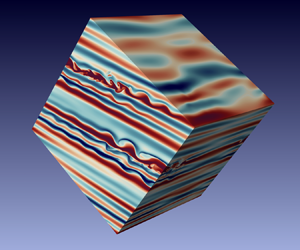Article contents
Simulating turbulent mixing caused by local instability of internal gravity waves
Published online by Cambridge University Press: 19 March 2021
Abstract

With the aim of assessing internal wave-driven mixing in the ocean, we develop a new technique for direct numerical simulations of stratified turbulence. Since the spatial scale of oceanic internal gravity waves is typically much larger than that of turbulence, fully incorporating both in a model would require a high computational cost, and is therefore out of our scope. Alternatively, we cut out a small domain periodically distorted by an unresolved large-scale internal wave and locally simulate the energy cascade to the smallest scales. In this model, even though the Froude number of the outer wave,  $Fr$, is small such that density overturn or shear instability does not occur, a striped pattern of disturbance is exponentially amplified through a parametric subharmonic instability. When the disturbance amplitude grows sufficiently large, secondary instabilities arise and produce much smaller-scale fluctuations. Passing through these two stages, wave energy is transferred into turbulence energy and will be eventually dissipated. Different from the conventional scenarios of vertical shear-induced instabilities, a large part of turbulent potential energy is supplied from the outer wave and directly used for mixing. The mixing coefficient
$Fr$, is small such that density overturn or shear instability does not occur, a striped pattern of disturbance is exponentially amplified through a parametric subharmonic instability. When the disturbance amplitude grows sufficiently large, secondary instabilities arise and produce much smaller-scale fluctuations. Passing through these two stages, wave energy is transferred into turbulence energy and will be eventually dissipated. Different from the conventional scenarios of vertical shear-induced instabilities, a large part of turbulent potential energy is supplied from the outer wave and directly used for mixing. The mixing coefficient  $\varGamma =\epsilon _P/\epsilon$, where
$\varGamma =\epsilon _P/\epsilon$, where  $\epsilon$ is the dissipation rate of kinetic energy and
$\epsilon$ is the dissipation rate of kinetic energy and  $\epsilon _P$ is that of available potential energy, is always greater than 0.5 and tends to increase with
$\epsilon _P$ is that of available potential energy, is always greater than 0.5 and tends to increase with  $Fr$. Although our results are mostly consistent with the recently proposed scaling relationship between
$Fr$. Although our results are mostly consistent with the recently proposed scaling relationship between  $\varGamma$ and the turbulent Froude number,
$\varGamma$ and the turbulent Froude number,  $Fr_t$, the values of
$Fr_t$, the values of  $\varGamma$ obtained here are larger by a factor of about two than previously reported.
$\varGamma$ obtained here are larger by a factor of about two than previously reported.
- Type
- JFM Papers
- Information
- Copyright
- © The Author(s), 2021. Published by Cambridge University Press
References
REFERENCES
- 11
- Cited by





